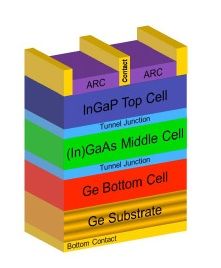Are there better solutions to get to higher efficiency photovoltaics?
Harry Atwater's group at Caltech and ARPA-E believe there are.
ARPA-E just awarded $2.4 million to Atwater's group to develop ultra high-efficiency photovoltaics as part of this week's $130 million funding flood from ARPA's Open 2012 program. The $2.4 million is for Atwater's group to set the groundwork for solar cells in the 50 percent to 70 percent efficiency range.
Single p-n junction crystalline silicon cells have a theoretical efficiency ceiling of 33.7 percent (the Shockley–Queisser limit). The best commercial c-Si cells from SunPower (Nasdaq: SPWR) clock in at 24 percent efficiency. Alta Devices has set gallium arsenide (GaAs) solar cell efficiency records at 27.6 percent.
An infinite-junction solar cell under concentrated sunlight has a theoretical limit of 86 percent. The real-world record is held by Solar Junction at 44 percent in a triple-junction cell at 947 suns.
Atwater believes that a combination of light management at the nanoscale and clever device architecture can yield "a quantum leap" in cell efficiency.
Today's "series" triple-junction cells stack three photovoltaic semiconductors on top of each other. Each semiconductor is optimized for a specific wavelength range. But the series nature of the device means that an enormous effort is spent in the growth of the layers, as well as separating or buffering the layers. The layer with the lowest current limits the current for the chip and minimizes the power generated.
The Caltech project envisions a photovoltaic device that eliminates the stack in favor of a parallel architecture where an optical system splits the beam into sub-bands and directs it to the appropriate semiconductor material. This architecture is not new -- Allen Barnett's group at the University of Delaware has explored this layout as part of DARPA's Very High Efficiency Solar Cell (VHESC) program, as has MIT Lincoln Labs -- but materials and optical design remain open to optimization. Atwater said that he envisions anywhere from six to fifteen sub-bands and cells. "The more subcells, the lower the thermal penalty," said Atwater in an interview last week with GTM.
"By systematically addressing the thermodynamic efficiency losses in current photovoltaics, a next phase of photovoltaic science and engineering -- ultrahigh-efficiency photovoltaics -- is at hand," according to Atwater in an article co-written with Albert Polman in Nature Materials (Vol. 11, March 2012).

Conventional architecture of triple-junction solar cell

Spectrum-splitting scheme suggested by MIT Lincoln Labs in 1982. From "Optimal design of high-efficiency tandem cells," J. C. C. Fan, B.-Y. Tsaur, and B. J. Palm, Proc. IEEE PVSC, 1982, p. 692.

Potential efficiencies of many-junction solar cells -- from DARPA
The architecture, materials, and construction proposed by Atwater's group are cutting-edge science. The light-trapping techniques such as photonic crystals, plasmonic designs, and resonant-guided wave networks are more laboratory novelties than commercially deployable processes. Some of the required beam-splitter technologies are already used in optical communications and photonic integrated circuits such as wavelength-division multiplexers.
Atwater sees the precision and complexity levels required for this type of CPV device along the lines of automotive LED lighting. He views it as a design problem that would yield a low-cost solution once high volumes had been achieved.
This type of research project has a set of risk factors that would likely prevent a venture capital firm from investing, despite Atwater's lab-to-market track record (the GaAs technology at Alta Devices has its genesis with Atwater and his colleague, Eli Yablonovitch. Alta is funded by Kleiner Perkins, August Capital, Crosslink Capital,Technology Partners, et al.). This project is probably too early even for angel investors.
But it is elegant science, and few would suggest that the government has no place in funding basic research.
As Cheryl Martin, Deputy Director for Commercialization for the Advanced Research Projects Agency – Energy (ARPA-E), said at a recent AlwaysOn event, ARPA-E is about "funding things that other people won't fund."



